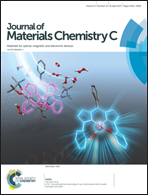Efficient deep red electroluminescence of iridium(iii) complexes with 2,3-diphenylquinoxaline derivatives and tetraphenylimidodiphosphinate†
Abstract
Four novel iridium(III) complexes (Ir1–Ir4) containing 2,3-diphenylquinoxaline derivatives with or without fluoro-substituents at different positions (L1: 2,3-diphenylquinoxaline; L2: 6,7-difluoro-2,3-diphenylquinoxaline; L3: 2,3-bis(4-fluorophenyl)quinoxaline; L4: 6,7-difluoro-2,3-bis(4-fluorophenyl)quinoxaline) as the main ligands and tetraphenylimidodiphosphinate as an ancillary ligand were synthesized and thoroughly investigated. All the complexes emit deep red photoluminescence (PL) with high quantum yields (Ir1: λmax: 662 nm, ηPL: 68.2%; Ir2: λmax: 669 nm, ηPL: 60.4%; Ir3: λmax: 639 nm, ηPL: 78.6%; Ir4: λmax: 642 nm, ηPL: 98.3%). Organic light-emitting diodes (OLEDs) with single- or double-emitting layers (EMLs) were fabricated using these new emitters. The double-EML device using Ir4 with a structure of ITO (indium-tin-oxide)/MoO3 (molybdenum oxide, 5 nm)/TAPC (di-[4-(N,N-ditolyl-amino)-phenyl]cyclohexane, 30 nm)/TcTa (4,4′,4′′-tris(carbazol-9-yl)triphenylamine): Ir4 (2 wt%, 10 nm)/26DCzPPy (2,6-bis(3-(carbazol-9-yl)phenyl)pyridine): Ir4 (2 wt%, 10 nm)/TmPyPB (1,3,5-tri(m-pyrid-3-yl-phenyl)benzene, 40 nm)/LiF (1 nm)/Al (100 nm) displays good electroluminescence (EL) performance with a maximum luminance, current efficiency, power efficiency and external quantum efficiency of up to 25 926 cd m−2, 16.6 cd A−1, 13.7 lm W−1 and 19.9%, respectively, and the efficiency roll-off ratio is mild. The results demonstrated that the number and position of fluoro-substituents can affect both the PL and EL properties of the Ir(III) complexes, which are potential deep red phosphorescent materials for specific applications in OLEDs.



 Please wait while we load your content...
Please wait while we load your content...